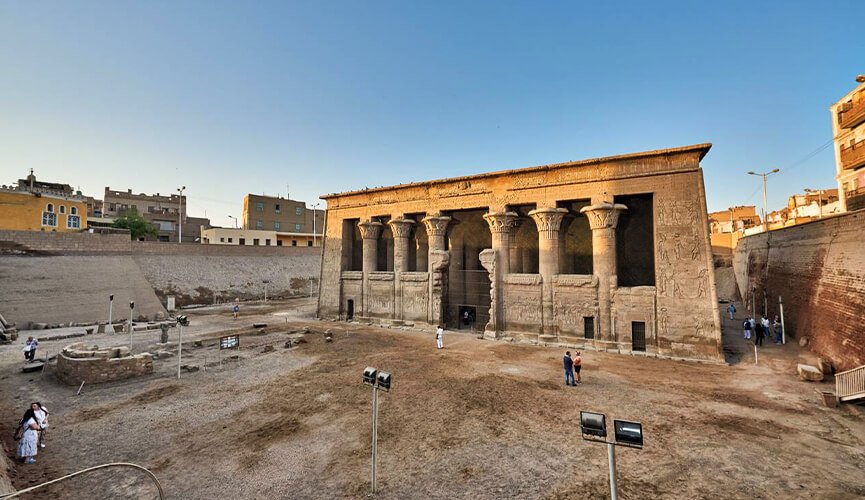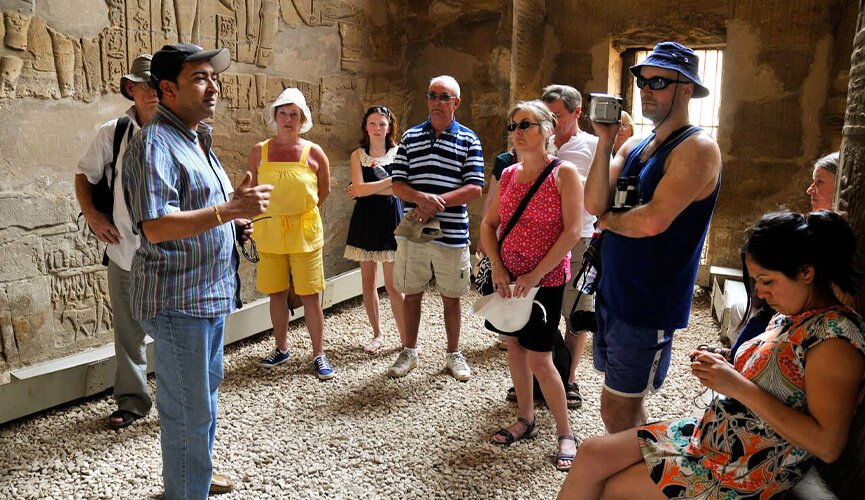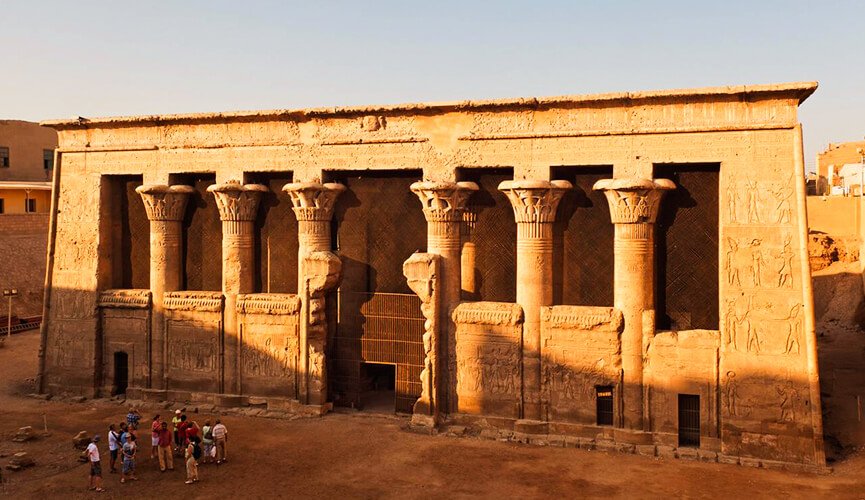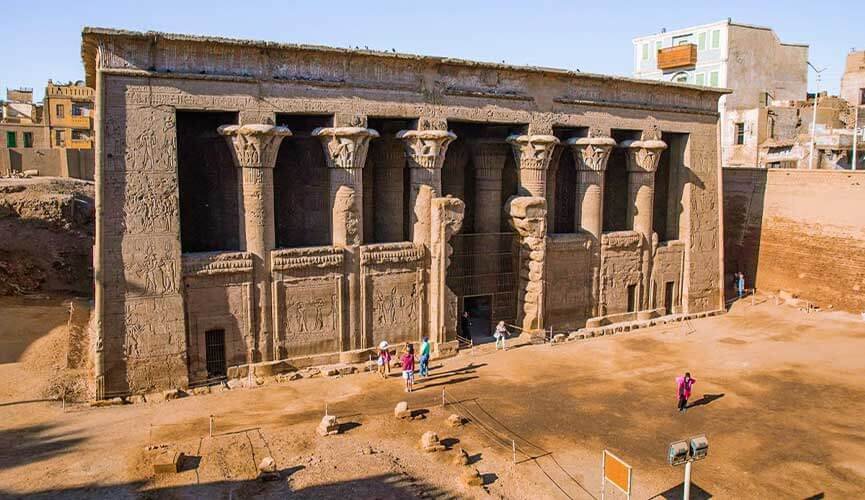The Temple of Esna is a beautiful temple from ancient Egypt. It is in the city of Esna, which is on the banks of the Nile River. The temple was built during the time of the Ptolemies and the Romans. It is one of the best-preserved and most attractive temples of its kind. The temple is for the god Khnum, who made the world and the river Nile. Khnum was thought to have made babies and flooded the Nile, which was necessary for the area’s agriculture.
The Temple of Esna is an essential part of ancient Egyptian culture because it shows how the people who built it felt about their religion and culture. The temple’s decorations and writings tell us a lot about the ancient Egyptians’ religious views and ways of life. As such, it is an integral part of Egypt’s ancient history and has a lot of value. The temple is essential for more than just its religious and cultural worth. It is also vital for its architecture and art. Ancient Egyptians were very good at art and building; the temple is an excellent example.
This blog post aims to explain the Temple of Esna’s history and importance and how it shows the ancient Egyptians’ religious, cultural, artistic, and building successes. Through this blog post, we hope to help people learn about old Egyptian culture and get more people interested in and learning about this rich and unique culture.
History of the Temple of Esna

A. Original Construction
In the third century BC, the Temple of Esna was first built when the Ptolemaic family was in power. It was in honor of the gods Khnum, Neith, and Heka. The new temple complex was built on the site of an older temple. It had an impressive facade and a very detailed interior. Over time, the temple became a significant place to serve the gods, and people came from all over the land to visit it.
B. Additions and Renovations
The Temple of Esna has changed and been fixed up in many ways over the years. Several new buildings, like a theater and a church, were added to the site during the Roman era. The building was also covered with reliefs and paintings that were very detailed and showed scenes from Egyptian folklore.
C. Reconstruction Efforts
Recently, the Temple of Esna has been fixed up in several important ways. In the 19th century, parts of the temple were removed to use building materials in nearby projects. The temple was made as beautiful as it used to be in the 1960s. The temple is now open to the public and is a famous place for tourists and people interested in history to visit.
In the end, the Temple of Esna is an excellent example of the building and society of ancient Egypt. Its long past shows how powerful and essential the Egyptian gods were, and it still makes people feel awe and wonder when they visit.
Design and Architecture of the Temple of Esna

The Temple of Esna is one of ancient Egypt’s most impressive buildings. It was built during the time of the Ptolemies, and its style and building show how great the people of that time were. Because of the unique style of the Ptolemaic time, the temple is full of decorations and tiny details.
A. The façade
One of the most unique parts of the Temple of Esna is its front. The entrance to the temple is a tall tower 30 meters high. On each side, there are two tall towers with statues of lions. The gods and pharaohs carved into the beautiful front of the temple come to life when the sun shines on them.
B. The interior
The inside of the Temple of Esna is just as impressive. The temple has many different rooms and halls, each with designs and symbols. The hypostyle hall, which has 24 columns on each side, is the most well-known room in the temple. Six of these columns have pictures of the goddess Hathor, and the rest have caps in the shape of lotuses.
C. Decorative parts
The Temple of Esna is full of beautiful and enchantment-inducing decorations. The walls are covered with carvings of King Horemheb and Pharaoh Sety I’s victories over their enemies. These images prove how powerful and successful Egypt’s great kings were. The temple also has a lot of pictures of the sun god Ra, who is Esna’s guardian god.
In the end, the design and construction of the Temple of Esna say a lot about the people who made it, their artistic skills, and their loyalty to their gods. The temple is an excellent example of an old Egyptian building, and the stories of Egypt’s great kings and gods are still “alive” on its walls.
Significance of the Temple in Egyptian Beliefs

- In ancient Egypt, the Temple of Esna was an essential place of worship for several vital gods and goddesses. In the temple, statues and other works of art showed how these gods affected the lives of the people who honored them.
- Many important religious events took place at the Temple of Esna, a place of worship for people from all over the area. In these events, the gods and goddesses thought to control parts of the natural world and the future were often appeased and honored with elaborate rites and gifts.
- In addition to being an essential part of daily religious life, the Temple of Esna was also a big part of how ancient Egyptians thought about the future. People believed the temple was a doorway to the world of the gods and that those who could get through the temple’s routines and ceremonies would live forever.
- Overall, the Temple of Esna is an integral part of ancient Egypt’s spiritual history, and it continues to teach us about the complicated beliefs and rituals of this ancient society. Whether you are interested in history or want to learn more about how people used to worship in the past, the Temple of Esna is an exciting and moving place that guests from all walks of life will surely enjoy and learn from.
Modern-day Visit to the Temple of Esna

When people go to the Temple of Esna, they will have an experience they will never forget. The building has paintings and hieroglyphics that give us a look into the culture and society of ancient Egypt. The level of detail that these old artists were able to achieve is truly unique.
The temple is important from a historical point of view, and the site is also in good shape. This is primarily because of what the Egyptian government and other groups working to preserve historical places have done. It’s encouraging to see that these buildings are still standing after thousands of years. They tell us a lot about the past of our world.
Of course, there are always worries about preserving and protecting any place that gets a lot of tourists. The Temple of Esna is well cared for, which is good news. Visitors cannot touch or mess with any of the drawings or hieroglyphics. The site is also checked and fixed daily to ensure it stays in good shape for people to enjoy in the future.
In conclusion, anyone interested in old history or Egyptian culture must visit the Temple of Esna. It’s easy to get to and has a rich past. It’s also in good shape, so the experience will surely stick with you.
Conclusion
- A. A summary of the Temple of Esna and what it meant The Temple of Esna shows how important cultural-historical places are for keeping a people’s past and culture alive. During the Ptolemaic era, this temple was built as a place of worship for the god Khnum, who was thought to have made the Nile River. The temple’s wall reliefs are in great shape, showing magical scenes of gods and pharaohs. They are a vital part of understanding ancient Egyptian religion and folklore.
- B. A look back at the blog post As we looked around the Temple of Esna, it became clear how important it is to keep these cultural and historical places safe for the future. We could lose a lot of important information about our past and culture if we don’t keep these sites around. This blog post is a call to action for everyone to take care of cultural heritage places like the Temple of Esna and help protect them.
- C. A call to action to protect cultural property places like the Temple of Esna Cultural historical places like the Temple of Esna need to be protected and kept in good shape as a top priority. By spreading the word and giving money, we can ensure these places will be around for future generations. Also, we need to encourage tourists to visit these places in a way that respects their cultural and historical value. We all have a part to play in keeping our shared past alive, and the first step is to understand how important cultural heritage is. Let’s do something to keep these critical places around for future generations.
Remember to add the Temple of Esna to your plans for your next trip to Egypt. This old temple in Esna is a must-see for anyone interested in ancient Egyptian history.
If you only have a short time in Egypt, you should take one of the many Egypt day tours, including the Temple of Esna. Most of the time, these trips begin in Luxor, which is close to Esna. They include transportation, an experienced tour guide, and the entrance fee to the temple.
If you want to see more of Egypt, consider booking an Egypt Nile cruise that stops at the Temple of Esna. The length of these vacation deals varies, but most of them last between 5 and 10 days. In addition to visiting the temple, you’ll see other historical places along the Nile River and enjoy the luxury comforts of a Nile tour ship.

